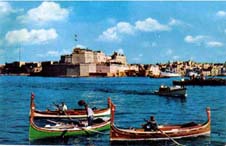BY CHARLES FLORES

Photo - Edward Clarke
The picture of Malta's spectacular Grand Harbour is never complete without the colourful elegance of the dghajsa, the traditional passenger boat that has survived through the centuries incredble from Phoenician times.
Like an ageless ballerina dancing on the. water, the dghajsa may give the impression of fragility as it glides smoothly past the oil tankers and huge white tourist liners to cross the ancient harbour, from one special site to another... historical forts, bastions and underground silos, mediaeval palaces and winding wharves, busy shipyards and quaint little bays. But it is, in truth, quite a sturdy boat that can adapt itself remarkably well to both the oar and the modern outboard motor with a maximum of ten passengers if and when required.
That maximum was often mandatory during the British era when thousands of sailors used the dghajsa services to go ashore and back on board the Royal Navy ships of the Mediterranean fleet that used Malta as a strategic base. Many an old barklor, as the dghajsa's oarsman is popularly known in Maltese, will tell you a whole collection of amusing, sometimes sobering, anecdotes like the problems he used to have with drunken sailors wanting to stay standing on the boat and how he solved them, or when the late Lord Mountbatten preferred the dghajsa for the all-polished copper Admiral's boat, or when a wanted murderer had actually disguises himself as a sailor and so on and so on. While you do notneed to believe it all, you can enjoy reading the delightful names that the oarsmen give to their boats and observing the mysterious paintings and sculptures they adorn them with.
The dghajsa is known to have offered the same reliable service to the fleets of the other imperial nations that once ruled over the Maltese Islands, from the French and the Knights of St John to the Arabs and the feudal lords of Europe.
One just can't help comparing the dghajsa with Venice's gondola which is known to have evolved from the same Phoenician prototype. That the two boats are sisters is a fact testified in the maritime records of the Venetian Republic.
In modern times, the dghajsa has for many years had to face an uncertain future. The only new boats being built were those for the annual 8th September Regatta, a series of races that go back to the time of the Knights and in which feature, sometimes rather too boisterously, the ardent crews from the towns and villages on the harbour coast line, Marsa, Kalkara, Vittoriosa, Cospicua, Senglea, the current Aggregate Shield Holders and Marsamxett (Valletta).
The traditional Regatta is a major sporting event on the Maltese calendar and locals and visitors alike descend upon the shores of Valletta to watch the colourful spectacle. There is no prouder moment for the dghajsa as it demonstrates its sturdiness without losing any of its elegance. People who watch the races for the first time often express surprise at the speed the two-oared and four-oared dghajjes manage to attain merely on muscle power.
The old boat-builders of Vittoriosa, Kalkara, Senglea and Cospicua, however, were gradually closing shop either to go into well-deserved retirement or to earn their daily bread doing something more profitable. Sadly, few had the wisdom or the foresight to pass on their delectable craft to the younger and certainly eager generation.
But the advent of tourism, that has outgrown ship repairing to become the Island's major industry, has happily provided the shining light at the end of the tunnel. The accent on new tourist attractions in the Three Cities area of Grand Harbour is rightly expected to include a more than welcome rehabilitation of the dghajsa. Tourists will be able to take scheduled dghajsa rides to visit the various attractions during the day and, on boats bedecked with flickering little lanterns, to make it more of a romantic affair in the evening.
To help in this ambitious project, the barklori have in turn agreed to help themselves by setting up a cooperative. The few boat-builders that remain may now be tempted to look for work beyond the September races and in so doing, to employ a number of apprentices who would hopefully ensure the continuation of their craft in the future.
A dghajsa ride is a hugely relaxing experience. The boat is amazingly swift and manageable at the same time. Both the old, pipe-toting oarsman and the young barklor who switches off his home PC to do some part-time work on uncle's 80year-old dghajsa - either of whom may happen to be your host - make it look so easy with their strong arms and a natural dexterity.
Keeping the dghajsa in good working condition is a daily concern. The Maltese sun causes havoc with the paintwork and the thin wood masterfully twisted into that beautiful shape also needs constant attention.
A whole industry was created in the past to provide the craftsmen (qalfata) who could maintain the dghajjes as well as their fishing relations, the luzzi. No boat was fit to go afloat unless their fingers had done wonders on the hairline space between its outer panels.
The oldest surviving dghajsa can be found at the Senglea Regatta Club where members have kept it stored away from the elements. It is over 150 years old and the family that owns it rightly insists it should stay there for posterity.
But as you seek to hail one from the small flotilla of dghajjes for your next ride, don't be surprised to know that some of them could be 80, even 90 years old, still looking good and inviting. The "young ones", 20, 30 or 40 years old, also competing for your custom, you would recognise from their names ("Elvis", "Rocky", "Dallas"..).
The younger ones still need to be built.

